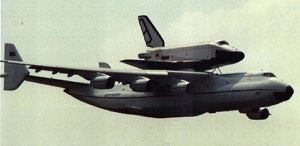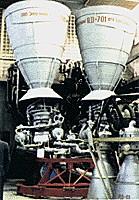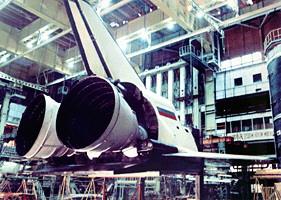








MAKS Spaceplane
Encyclopedia Astronautica
Buran Atop Mriya
Buran atop its An-225 Mriya carrier, as displayed
at the Paris Air show shortly after its spaceflight.
Credit: © Mark Wade
In 1976-1981 it was realised that launch of Spiral from a large transport was feasible and of much lower development cost than the previous approach using a supersonic launcher. Further it was realised that a smaller orbital spaceplane would have many advantages compared to the Buran space shuttle then in development. These included quicker turnaround, more launch flexibility, and a wider range of achievable orbits. The MAKS approach would allow launch of payloads into orbit; working on satellites in orbit; and return of payloads to earth.
The MAKS design was superior to the earlier System 49 and Bizan designs in several ways. The single-stage-to-orbit allowed the propellant tank to be dropped safely into the antipodal ocean after launch, whereas the '49' with separate rocket stages was constrained to launch points where a first stage impact point 2000 km away was available. MAKS was more reusable than Bizan since all of the engines would be recovered; only the propellant tank was expendable. Finally., the availability of the An-225 transport meant that a larger spacecraft could be designed.
The MAKS draft project used 3 x NK-45 Kuznetsov Lox/LH2 engines with 90 tonnes thrust each. This design had 250 tonne flight mass and a 7 tonne net payload. Switch during development to the RD-701 tripropellant engine improved the design. The higher-density propellants allowed a smaller, lighter tank with an increase of the net payload to 8.4 tonnes.
Studies indicated that the optimum launch angle for MAKS was 45 degrees. But to attain this with the An-225 transport a rocket engine would have to be installed in the launch aircraft, which was undesirable from a development standpoint and would also cut into the gross mass of the MAKS vehicle. Finally a tank geometry, and engine/orbiter arrangement was found that allowed the proper release conditions without requiring a supplemental rocket engine in the transport.
The mix and arrangement of propellant tanks changed during development. At first the oxidiser cell was placed at the front of the drop tank. This was aerodynamically stable but resulted in excessive static loads. Other locations posed insurmountable problems with the vehicle's aerodynamic moment and separation from the carrier aircraft. Putting the entire vehicle under the launch aircraft was considered, but this would require redesign of the An-225. There were finally two choices: either an unstable design, with the wings of the MAKS orbiter pitching the vehicle up 45 degrees immediately at release; or three cylindrical tanks arranged under the orbiter in a 'Siamese' arrangement. This last solution was favoured by TsAGI Central Hydrodynamics Institute, but the design bureau felt the weight penalty was too great.
The final layout had a complex form, with the thrust vector running below the axis of the drop tank. This 'tug' arrangement basically turned the drop tank into a barge with the orbiter pushing it into orbit. This solution had the lowest mass, was the best for a variety of abort situations, produced the best separation of the orbiter from the tank, and allowed a clear field for use of the crew ejection seats in an emergency.
The MAKS expendable-tank solution also produced a higher payload fraction to orbit than competing integrated vehicle approaches (such as I-HOTOL / MAKS-M or VKS-O). This provided a better margin in case of vehicle weight growth. The drop-tank / lightweight orbiter approach also reduced the amount of orbital manoeuvring propellant required, which allowed heavier payloads to be placed into high altitude orbits than pure single-stage-to-orbit designs.
The MAKS air-launched manned space system weighed 620 tonnes on takeoff and consisted of three elements:
- An-225 Mriya carrier aircraft, the largest in the world,
originally developed to transport the Buran orbiter. The Mriya would
take the 275 tonne MAKS piggy-back a launch position appropriate for the
target orbit. The optimum release manoeuvre involved a dive from 7.8
km altitude to 6.8 km over a 7 km distance. The transport would then
pull up, releasing MAKS at 8.6 km altitude and 900 km/hr. After release
the transport nosed over, reaching a peak altitude of 8.8 km, levelling
out at 8.2 km 20 km from the start of the manoeuvre.
- External tank. This carried liquid oxygen, kerosene,
and liquid hydrogen propellants. It was 6.38 m in diameter and 32.1 m
long, with a total mass of 248,000 kg and an empty mass of 11,000 kg.
- MAKS Orbiter. This spaceplane, designed for 100 reuses, used on-board systems based on those already developed for Energia and Buran. The orbiter had an empty mass of 18,400 kg, with a wingspan of 12.5 m and a length of 19.3 m. The aerodynamic shape was refined considerably from that of Spiral / 49 / Bizan to accommodate the main engine installation in the tail. An unmanned version could deliver 9.5 tonnes to a 200 km, 51 degree orbit in a payload bay 2.8 m diameter x 8.7 m long. The manned version took two crew and a payload of 8.3 tonnes in a bay 2.8 m diameter x 6.8 m long to the same orbit. In the orbiter's tail were two RD-701 tripropellant engines. These were designed for 15 re-uses and used dense kerosene and liquid oxygen for initial operations, then switched modes to a reduced thrust and higher specific impulse using low density liquid hydrogen and liquid oxygen. This reduced the size of the huge hydrogen tank otherwise required. The RD-701 engine assembly in the MAKS had a total mass of 3990 kg and delivered a total thrust of 400,000 kgf at separation from the An-225.
Stage Data - MAKS
- Stage 0. 1 x An-225. Gross Mass: 600,000 kg (1,320,000 lb). Empty Mass: 216,000 kg (476,000 lb). Thrust (vac): 1,387.072 kN (311,826 lbf). Isp: 9,000 sec. Burn time: 3,375 sec. Isp(sl): 8,000 sec. Diameter: 18.07 m (59.28 ft). Span: 88.40 m (290.00 ft). Length: 84.00 m (275.00 ft). Propellants: Air/Kerosene. No Engines: 6. Engine: D-18T. Status: Out of Production. Comments: Antonov cargo aircraft swept wing. Release conditions: Piggy-back, 275,000 kg, 38.0 m length x 24.0 m wingspan, 900 kph at 9,500 m altitude. Effective velocity gain compared to vertical launch 270 m/s.
- Stage 1. 1 x MAKS Orbiter. Gross Mass: 18,400 kg (40,500 lb). Empty Mass: 18,400 kg (40,500 lb). Thrust (vac): 3,618.771 kN (813,532 lbf). Isp: 437 sec. Burn time: 440 sec. Isp(sl): 396 sec. Diameter: 3.00 m (9.80 ft). Span: 12.50 m (41.00 ft). Length: 19.30 m (63.30 ft). Propellants: Lox/Kerosene/LH2. No Engines: 1. Engine: RD-701. Status: Development 1988.
- Stage 2. 1 x MAKS Tank. Gross Mass: 248,000 kg (546,000 lb). Empty Mass: 11,000 kg (24,000 lb). Thrust (vac): 0.0000 N ( lbf). Isp: 437 sec. Burn time: 440 sec. Isp(sl): 396 sec. Diameter: 6.38 m (20.93 ft). Span: 6.38 m (20.93 ft). Length: 32.10 m (105.30 ft). Propellants: Lox/Kerosene/LH2. No Engines: 1. Engine: None. Status: Development 1988.
Gross mass: 275,000 kg (606,000 lb).
Payload: 6,600 kg (14,500 lb).
Height: 39.00 m (127.00 ft).
Diameter: 6.38 m (20.93 ft).
Thrust: 3,900.00 kN (876,700 lbf).
Apogee: 400 km (240 mi).
Encyclopedia Astronautica
RD-701

RD-701
Credit: © Mark Wade

MAKS mockup - aft
MAKS mock-up - aft view of RD-701 engines
Credit: Dr.Vadim P.Lukashevich
Application: MAKS spaceplane.
Characteristics
Chambers: 2. Throttled thrust(vac): 1,588.000 kN (356,996 lbf). Thrust (sl): 1,406.100 kN (316,104 lbf). Thrust (sl): 143,384 kgf. Engine: 3,670 kg (8,090 lb). Chamber Pressure: 294.00 bar. Area Ratio: 133.8. Thrust to Weight Ratio: 111.22. Oxidizer to Fuel Ratio: 6.
Status: Development ended 1988.
Unfuelled mass: 3,670 kg (8,090 lb).
Height: 5.70 m (18.70 ft).
Diameter: 2.30 m (7.50 ft).
Thrust: 4,003.00 kN (899,910 lbf).
Specific impulse: 415 s.
Specific impulse sea level: 330 s.
Burn time: 440 s.
First Launch: 1988-.
Encyclopedia Astronautica
Lox/Kerosene/LH2

RD-701
Credit: © Mark Wade
Rocket propellant RP-1, or its foreign equivalents, is a straight-run kerosene fraction, which is subjected to further treatment, i.e., acid washing, sulphur dioxide extraction. Thus, unsaturated substances which polymerise in storage are removed, as are sulphur-containing hydrocarbons.
Fuel: Kerosene/LH2. Propellant Formulation: Lox/Kerosene/LH2. Optimum Oxidizer to Fuel Ratio: 4.8. Density: 0.50 g/cc. Fuel Density: 0.133 g/cc. Fuel Freezing Point: -259 deg C. Fuel Boiling Point: -253 deg C.
Tripropellant. Figures indicated are average for RD-701 engine.
Specific impulse: 440 s.
Russia Shows Off New Manned Spacecraft To Replace Aging Soyuz
http://www.techtimes.com/
By Jill Arce, Tech Times | August 31, 1:20 AMThe manned space transport has not yet been given a name, but has already been displayed to the public for the first time Monday.
The Russian Space Agency presented photos of this spacecraft at Moscow's MAKS-2015. Along with this new Russian development displayed at the 12th International Aviation and Space Station at Hall D1 were the Roskosmos and ACCD built by leading Russian enterprises and 19 other space industry exhibits.
This "new generation new transportation spacecraft" is being developed by RSC Energia which has been involved in the rocket-space industry since 1946. The manned spacecraft is designed to replace Soyuz-TMA which was issued by the Russian Federal Space Agency and features changes according the NASA's requirements as well as service the International Space Station (ISS). Some of the features of the aging spacecraft include more latitude in the crew's height and weight, better parachute systems and a glass cockpit.
The new spacecraft which has been under development for about a decade now will send astronauts to further explore the moon and Mars. The development is a part of the Prospective Protected Transport System 9PPTS) aimed at replacing not only the Soyuz-TMA but also the Progress Cargo ships. The long-awaited testing of the capsules will take place over the next few months. In 2021, this new spacecraft will be test launched in an unmanned orbital flight atop the new Angara rocket from the new Russian spaceport Vostochny Cosmodrome, also currently being constructed.
While space enthusiasts await the new Russian spacecraft's first unmanned test flight, its developer RSC Energia announced the launching of a competition for a name.
The creativity competition will run from Aug. 30 through Nov. 2 this year, with results to be announced Jan. 15 next year.
Deliberations of a judging panel and votes of the public will decide on the best suggested name and the winner of the competition. If naming this new spacecraft isn't a prestige enough, the winner will also have the chance to watch the Soyuz spacecraft take off in the launch of a manned spaceflight in Baikonur spring of 2016.

No comments:
Post a Comment